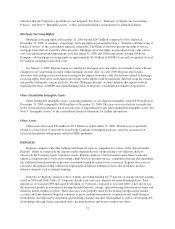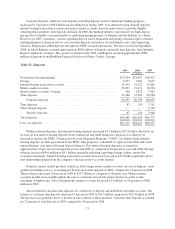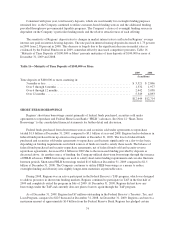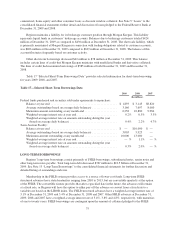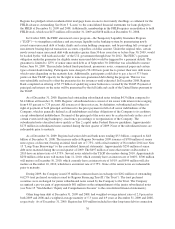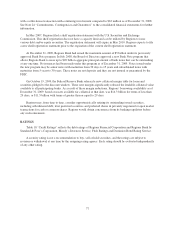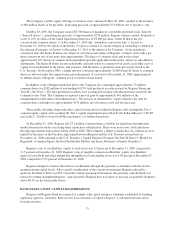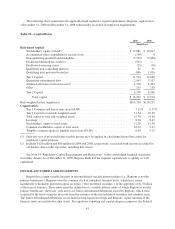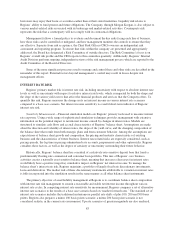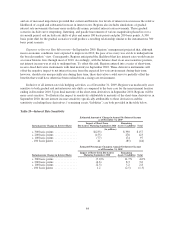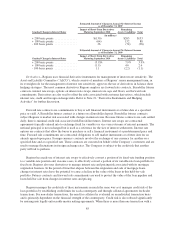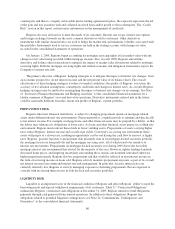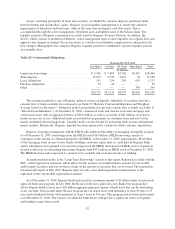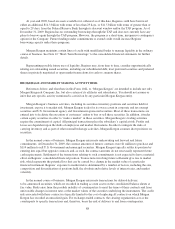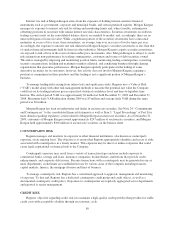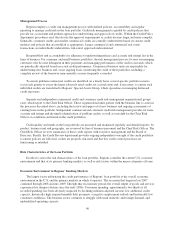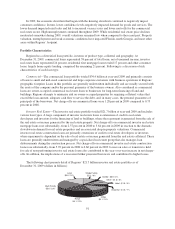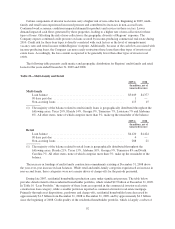Regions Bank 2009 Annual Report Download - page 96
Download and view the complete annual report
Please find page 96 of the 2009 Regions Bank annual report below. You can navigate through the pages in the report by either clicking on the pages listed below, or by using the keyword search tool below to find specific information within the annual report.Reserve Board has indicated that such trust preferred securities will continue to constitute Tier 1 Capital until
further notice. Additional discussion regarding the status of capital treatment for these instruments is included in
the “Supervision and Regulation” section of Item 1. of this Annual Report on Form 10-K.
Also, Regions periodically invests in various limited partnerships that sponsor affordable housing projects,
which are funded through a combination of debt and equity. Regions’ maximum exposure to loss as of
December 31, 2009 was $827 million, which included $258 million in unfunded commitments to the
partnerships. Additionally, Regions has short-term construction loans or letters of credit commitments with the
partnerships totaling $324 million as of December 31, 2009. The funded portion of these loans and letters of
credit was $150 million at December 31, 2009. The funded portion is included with loans on the consolidated
balance sheets. See Note 2 “Variable Interest Entities” to the consolidated financial statements for further
discussion.
EFFECTS OF INFLATION
The majority of assets and liabilities of a financial institution are monetary in nature; therefore, a financial
institution differs greatly from most commercial and industrial companies, which have significant investments in
fixed assets or inventories that are greatly impacted by inflation. However, inflation does have an important
impact on the growth of total assets in the banking industry and the resulting need to increase equity capital at
higher than normal rates in order to maintain an appropriate equity-to-assets ratio. Inflation also affects other
expenses that tend to rise during periods of general inflation.
Management believes the most significant potential impact of inflation on financial results is a direct result
of Regions’ ability to manage the impact of changes in interest rates. Management attempts to maintain an
essentially balanced position between rate-sensitive assets and liabilities in order to minimize the impact of
interest rate fluctuations on net interest income. This goal, however, can be difficult to completely achieve in
times of rapidly changing rate structure. Refer to Table 20 “Interest Rate Sensitivity” for additional details on
Regions’ interest rate sensitivity.
EFFECTS OF DEFLATION
A period of deflation would affect all industries, including financial institutions. Potentially, deflation could
lead to lower profits, higher unemployment, lower production and deterioration in overall economic conditions.
In addition, deflation could depress economic activity and impair bank earnings through increasing the value of
debt while decreasing the value of collateral for loans. If the economy experienced a severe period of deflation,
then it could depress loan demand, impair the ability of borrowers to repay loans and sharply reduce bank
earnings.
Management believes the most significant potential impact of deflation on financial results is a direct result
of Regions’ ability to maintain a high amount of capital to cushion against future losses. In addition, the
Company’s risk management can utilize certain tools to help the bank maintain its balance sheet strength even if
a deflationary scenario were to develop.
RISK MANAGEMENT
Risk identification and risk management are key elements in the overall management of Regions.
Management believes the primary risk exposures are credit risk, market risk and associated interest rate risk,
prepayment risk, liquidity risk, market and other brokerage-related risk associated with Morgan Keegan and
counterparty risk. Credit risk represents the possibility that borrowers may not be able to repay loans. Market risk
is the risk of loss arising from adverse changes in the fair value of financial instruments due to changes in interest
rates, exchange rates, commodity prices, equity prices or the credit quality of debt securities. Interest rate risk is
the risk to net interest income due to the impact of movements in interest rates. Prepayment risk is the risk that
82


